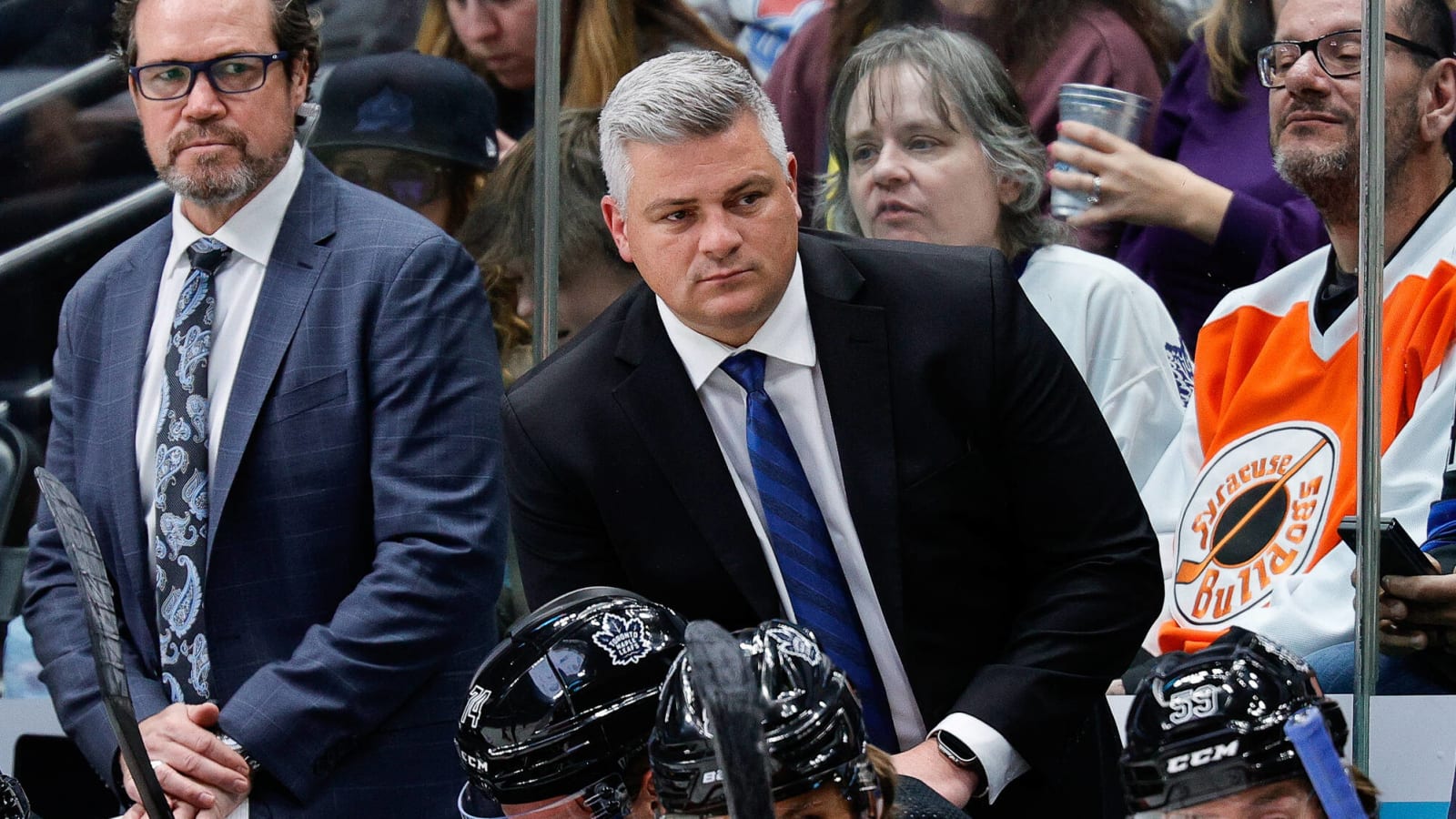Throughout every Maple Leafs season, we discuss so many topics and themes about the team in this space that it behooves me to track the major ones and follow up on them as the season progresses.
Last offseason, I was continually drawn to this topic: Brad Treliving keeping Sheldon Keefe on as the team’s head coach, and how he framed his decision specifically. When he discussed his decision to retain Keefe, the Leafs GM outlined the following:
“One of the things we talked about is that I firmly believe we are all sometimes better in our second jobs. You see it sometimes with coaches. I think there is a little bit of that. I have talked about my relationship with Kyle. [Sheldon] has worked with Kyle for a long time. But sometimes a little bit of newness or freshness can help — a little bit of change.”
Even though Keefe already coached this team for four seasons and would have the same core group of players again in 2023-24, Treliving calling it essentially a new start and “second job” really struck me. It’s no secret that until this season, Keefe was tied to the hip of Kyle Dubas.
Treliving’s decision to keep Keefe was met with a lot of disdain at the time given the repeated playoff failures, but to me, it was understandable based solely on the coaching market in the summer. If there was a time to pull the trigger on a new coach, it was the previous summer when all of Bruce Cassidy, Pete DeBoer, and (technically) Barry Trotz were available. Last summer’s coaching hires included Peter Laviolette and Andrew Brunette, who are doing fine enough jobs for their respective teams, but they didn’t exactly leap off the page to me as clear upgrades on Keefe.
Treliving held firm and instead talked about a “second job” for Keefe.
The preseason started interestingly enough as the Leafs tried William Nylander out at center, something Keefe admitted was Treliving’s idea. That experiment lasted all of two preseason games even though there was nothing egregiously concerning enough to pull the plug on it completely. By the time the regular season started, the Leafs‘ familiar top-six alignment of Matthews-Marner and Tavares-Nylander was back together.
Frankly, much of the first half of the season looked familiar and played out as expected. The team lived or died on the backs of its top players. The third line barely played on most nights, and the Leafs‘ latest attempt at adding a tough guy, Ryan Reaves, found himself trending toward regular press-box duty.
The Leafs previously ran a setup geared towards the top six players eating and the rest of the team checking, but they brought in a new GM who added more talent and elevated young players — bringing additional offense but also defensive warts — with the idea of deploying a more “spread out” attack. Treliving downplayed the “core four” talk and spoke about building a team where everyone matters, one through 23.
Treliving’s idea of moving Nylander to center would facilitate the type of three-line attack he was picturing, but it didn’t happen. The lines and ice time returned to the previous form in short order, and it all felt disconnected for most of the first half. Treliving’s biggest summer signing, Tyler Bertuzzi, struggled to produce — despite receiving enough opportunity, in fairness — and Max Domi barely played.
Halfway through the season, Keefe bluntly stated he was looking for players he could trust: “Who are we going to rely on in those moments? Who’s going to go out and get the job done? 42 games in, I still have a lot of questions, quite honestly, about who is going to go out and you can say for certain is going to get the job done for us.”
While I wouldn’t declare Keefe to be a changed man — and nor should he radically change; he’s one of the winningest coaches in league history to this point in his career — I think we’re starting to see some signs of evolution.
In a January game against the Winnipeg Jets, the Leafs’ top players were responsible for a brutal sequence of events that led to a shorthanded 2v0 for the Jets. They were benched for an extended period, to say nothing of the tongue-lashing waiting for them when they got to the bench. Those are two reactions we had hardly ever seen from Keefe in years past.
In December, Keefe reportedly ran one of his most animated practices. In November, he called out the team for celebrating scoring but not playing defense. I’m sure he has always been more direct behind closed doors, but he’s been far more direct in public when addressing issues this year. Perhaps some of it was a sense of urgency to motivate a team that went through the motions in the first half of the season and battled some serious issues, particularly defensively.
Over the past month or so as the Leafs have piled up the wins, we’ve started to see a notably different approach.
This is a marked difference from previous “experiments” such as last season when the Leafs continually trotted out 11 forwards and seven defensemen down the stretch and experimented with different combinations on lines that weren’t set or rolling; that also revolved around the top players picking up extra minutes and attempting to compensate for a defense with various skill sets that didn’t form a well-rounded top-six unit. He has been locking in these new lines and taking a real look at them in a way that strategically makes the Leafs a different type of team to match up against.
Interestingly, Golden Knights head coach Bruce Cassidy talked about it from an opposition point-of-view this week, mentioning that he believes in the approach and it’s the one he embraced when Vegas won the Cup last spring. In a separate question about Nylander’s growth since Cassidy was behind the bench in Boston, Cassidy finished his answer by noting, “Now, they have moved some pieces around, so it makes it that much more difficult.”
It is a different look from the Leafs, and as Alec noted on Saturday, when the Leafs play a team such as the New York Rangers — top-heavy with two lines due to injuries to Blake Wheeler and Filip Chytil — Keefe had three lines to attack them with. All three scored at five-on-five in the game.
Some of this is also the natural byproduct of the Leafs introducing so many first-year (or first full-season) players to the regular forward mix, including Matthew Knies, Nick Robertson, and even older players such as Bobby McMann and Pontus Holmberg, who have never been true regulars in the league before. It has naturally come with its ups and downs and led to all sorts of line combinations throughout the first 60 games.
The convergence of all these factors is playing out late in the season. Against the Rangers, William Nylander pulled over to the wrong side of the ice and blew the zone looking for offense instead of taking care of business in his own end, so he rightfully sat for the rest of the first period. Keefe shifted lines around for the rest of the period without missing a beat.
In the second period, when Matthew Knies jumped up to stop a puck in search of offense instead of covering high while his two linemates were deep in the offensive zone — leading to a 3v2 goal the other way — he got yanked off the line and Pontus Holmberg promptly went on his wing. It’s an easy decision for Keefe because it’s a line they’ve already used with some success.
Overall, it’s becoming more fluid and interchangeable across the Leafs’ lineup depending on how players perform rather than the locked-in roster spots/roles with the familiar “it is what it is” vibe when the team struggles. Since February 1, the Leafs lead the NHL with 57 goals. They also lead the league in goals per game overall. This is a legitimate three-line attack that’s coming at the opposition in waves (and a number of their players have been red hot, too, of course, which helps).
My point isn’t to suggest Keefe has fully changed his methodology or coaching style since Brad Treliving has taken over as GM, but it’s clear there has been a bit of a shift in approach and an increase in accountability as the season has progressed. If and how it continues through the playoffs — where Keefe has traditionally overthought things — remains to be seen, but it has been a welcome change in the meantime and one worthy of some recognition.
Programming Note: The rest of my notebook — Notes, Quotes, Tweets of the Week, and 5 Things I Think I’d Do — will follow on Monday morning.

































